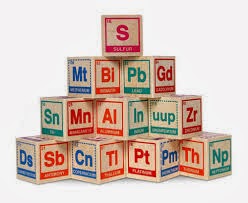 |
| Building blocks |
A short essay on what glass is made of, and what that stuff is made of.
Most
of us are aware that sand has something to do with glass, that silica
has something to do with sand and that somewhere in between silica has
something to do with glass. Let's begin with Gorilla glass as it is
fairly new as far as glass goes
and you might have a bit of it in your hand. The first, main components
of Gorilla glass are;
_________________________________________________________________
Alkali-aluminosilicate minerals.
- Alkali metals are a small number of chemical elements;
barium
(Ba), beryllium (Be), calcium (Ca), magnesium (Mg), radium (Ra) and
strontium (Sr). Using these metals to swap ions on the surface of glass
toughens it, making it more difficult to scratch.
 |
| Plain, transparent glass |
- Aluminosilicate (Al2SiO5) is a mineral composed of;
aluminium (Al), silicon dioxide (SiO2) and oxygen (O2).
The three are fused together with heat to make, glass. The glass is
then put in contact with monovalent ions, heat is again applied in order
to swap them for the smaller alkali metal ions in the glass.
Chemical Elements
 |
| Atomic structure of Glass |
The periodic table is a collection of pure
chemical elements. Aluminium is a pure chemical element. Bonding two or
more pure chemical elements together produces a compound chemical
element such as silicon dioxide; Silicon and Oxygen.
Monovalent Ions
- Monovalent. Valence is another word for the bonds you see between atoms that hold them together and mono, means one.
-
Ions. Simply any atom that have a net positive or negative charge
because the electrons and protons of the atom are not evenly balanced.
Atoms
 |
| Constituent parts of an atom |
All
the pure chemical elements are representative
of a single atom, each with it's own unique atomic number. The atomic
number represents the number of protons in it's nucleus (the electrons
too, as they have to be the same in number as the protons). If you have
two or more atoms conjoined to each other with our valent bonds you
have, a molecule.
An atom is comprised of electrons surrounding a
nucleus which is in turn
comprised of protons and neutrons (except Hydrogen-1 which has no
neutron);
- Electron. An elementary, negatively
charged subatomic particle that has about 0.05% the mass of a proton. An
electron is a fermion, a grouping for subatomic particles which means
it has a specific spin.
- Proton. A composite, positively charged subatomic particle made of three quarks. Two up quarks and two down quarks. Protons are also fermions.
- Neutron. Also a composite particle made of one up quark and two
down quarks. Neutrons are neither positive nor negatively charged and
have a mass slightly bigger than a proton. Neutrons fall under the
hadron group, the same as protons.
Quarks
 |
| One Proton = Three Quarks |
Another elementary particle, they get
together to form hadrons which are composite particles such as neutrons
and protons. Quarks are never found on their own, they only ever exist
together to form hadrons. There are six types of quarks known lovingly
as flavours;
-Up. An elementary fermion with the lowest
mass of all quarks. Up quarks experience all four fundamental
interactions; Gravitation, electromagnetism, weak and strong
interactions.
-Down. Almost exactly the same as an Up Quark but with a slightly larger mass.
-Strange (or S Quark). Heavier still than a down quark.
-Charm (or C Quark). Heavier than a strange quark.
-Bottom. A Bottom quark is a lot heavier than a charm quark, weighing in at nearly four times the mass of of a proton.
-Top. A top quark is appropriately named as it is not only the heaviest quark but the heaviest of all elementary particles. Due to it's enormous mass, top quarks are much used in particle experiments.
Fermions and Bosons
Fermions
include electrons, protons and quarks, all have a half integer spin.
Half-integers are half of an odd number of integers and any composite
particle made of an odd number, is a fermion. If a particle has a full
integer, it is a Boson.
All other elementary particles
that are not Bosons are Fermions. Bosons are like the glue for the
fermions as they can occupy two different quantum states/space at the
same time, where Fermions cannot.
To ask
you to travel any further into the minuscule of Hadrons, Baryons, Mesons
and beyond would be asking you to enter a zoo of umbrellas. As you can
see there is a lot that goes into making the screen you're looking at
and this is just one trifling example of how building blocks are put
together. Everything else in the universe works exactly the same way.
One brick on top of the other and there is no mystery except what is
beyond either end. The make up of subatomic particles yet to be
discovered, more complex materials yet to be invented. What is in the
middle is sure, physical, chemical, matter.
|
physics
chemistry
subatomic_particles
glass
chemical_elements
atoms
quarks
fermions_and_bosons
|
Hi, I do think this is a great site. I stumbledupon it ;) I may
ReplyDeletecome back once again since I book-marked it. Money and freedom
is the greatest way to change, may you be rich and
continue to help others.
Here is my homepage - Smash Bandits Racing Cheats
Hi smash bandits and thanks for your praise!
DeleteI wish to be free and I certainly will continue to help others... as for rich, I'm afraid that can only mean someone else has to be poor :(